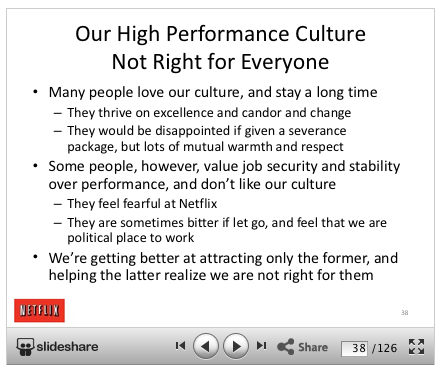Taking "High Performance" Seriously
I posted two weeks ago about the awesome slide deck that Netflix put up on SlideShare about their culture (that deck has been viewed 2.2 million times, by the way). My first post focused on only one of the seven points they make about their culture (“Values are what we value“).
Maddie then did a nice post about the Netflix view on the complementary nature of freedom and responsibility. As organizations grow, they start limiting freedom, and agility disappears. Netflix’s answer is to increase freedom by being disciplined about what rules to add and also by relying on (and trusting) exceptional employees to do a good job without too many rules.
In that post, Maddie asked me to do a post on the second of the seven points in the slide show, “High Performance.” Netflix makes a pretty bold statement here. They point out that while every organization certainly wants high-level employees, Netflix does something others don’t:
They fire adequate people.
Adequate performance gets you a “generous severance package.” They ask managers to think about who on their staff they would “fight hard to keep,” and then they ask them to basically get rid of everyone else so they can free up room for some more high performers. That’s bold. I don’t know a lot of organizations that would have that kind of courage.
Their approach is based on the assumption that in creative/inventive work, the star performers outperform adequate ones by a factor of 10 (I’d like to see the research on that, actually). For “procedural work” the best are only 2x better than the average.
So I have two points about this.
First, I like the idea of raising the bar. I like the idea of saying “if you want to come to work and do a constant C+, where you’re not completely failing but you’re not advancing us much either, then you’re gone.” Life is short, so let’s ratchet up our expectations a little and bring the best out in each other. I think we all win then. In Humanize we actually talk about the need to fire people (and the need to quit) when it’s not the right fit. The organization AND the employee deserve to have a match where the employee gets to be a star and deliver their gift to the world.
But I think there is a challenge here as well. Raising the bar implies, of course, that there is a bar–an objective measure to which everyone can compare themselves. Without that, then this idea of focusing only on “the best” becomes a subjective assessment, and that can be frustrating. When bosses and employees are disagreeing over who is a star performer and why, then it tends to get ugly. It gets “political.”
So then I see this slide in the deck:
Now, I agree that each culture is not right for everyone, and kudos to Netflix for helping people who don’t like it to get out, but I think the portrayal of the people who “don’t like our culture” as people who “feel that we are a political place to work” is what makes me nervous. What if it IS a political place to work? What if you’re loose about your definitions of star performers and everyone’s having to guess about what is going to be rewarded and what isn’t? Of couse I have no actual data about Netflix and what it’s really like to work there, and my point here really isn’t about Netflix, it’s about our own organizations:
How do we know who is a top performer and who isn’t? Can your employees actually measure that they have succeeded in some way at the end of the day? Would they know the difference between a B effort and an A effort? In Netflix’s values they say they want people who do “amazing amounts of important work.” What, exactly, is an “amazing” amount of work, and how do you define important?
I think most of us don’t define these things. We might have an intuitive sense, but we don’t articulate it, and it’s likely that people on the management team (who make the key decisions about these things) don’t see it the same way (which leads to the sense of it being “political”).
So if you want to get serious about “high performance,” then I say go for it. Let’s raise the bar. But get ready for the hard work of clarity. Get ready to spend some time (involving everyone) in determining what to measure (and how). And please don’t default to what we already know (hours worked, or overall organizational performance). We need more sophistication than that if we’re going to do this right (I was happy to see that Netflix says hours worked is “not relevant”). We can’t assume our people are like cogs in a machine, where we KNOW they accomplish more if they spin on their axis for 10 hours than they do if they spin for 8. We can’t oversimplify it and say if the company does well, then everyone is performing well. Let’s roll up our sleeves and experiment with some new metrics and try to learn enough from the experiments that we can create the clarity that would truly drive a “high-performance” culture.


2 Comments
Robert Barnes
You had me at “fire adequate people”.
Weekly Wrap-Up for September 7th! | Affiniscape Blog
[…] Taking “High Performance” Seriously by Jamie […]